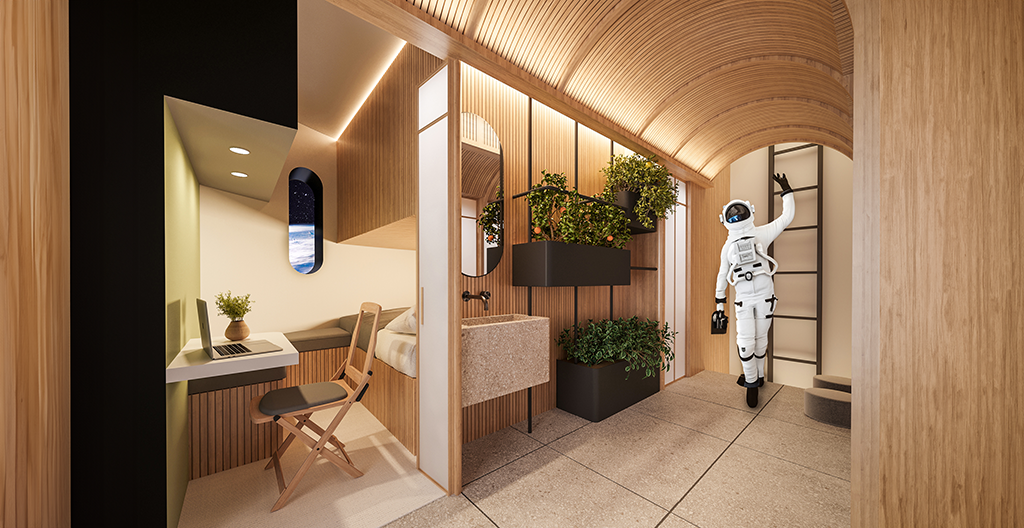What does an architect have to do with space travel?
Introduction
The role of the architect in human evolution goes beyond the creation of structures on Earth. Their influence now extends to space, playing a vital role in the evolution of humanity. In this article, we will explore how architects have not only contributed to the formation of terrestrial environments but are now also shaping our future in the exploration and habitability of space.
The Multidisciplinary Knowledge of the Architect
Design skills applied to space
Architects, by applying their design skills to space, are opening new frontiers for human habitability outside our planet. From the interior design of spacecraft to the planning of phased and progressive growth, their aesthetic vision and functionality are integrated to meet the unique challenges of space.
Integrating architecture into space exploration
Space exploration is not only about technology, but also about creating environments that allow humans to live and work in space. Integrating architectural principles into space exploration ensures that future generations will not only visit space, but also inhabit it in a sustainable manner.
Innovation in Space Architecture
Space Station Design
Architectural innovation manifests itself in the design of space stations that are more than just metal structures. Architects contribute to the creation of habitable spaces, taking into account ergonomics and comfort in zero-gravity conditions.
Development of sustainable habitats in space.
Sustainability is a central concern for space architects. Developing self-sufficient and sustainable habitats in space is essential for the long-term survival of humanity. Architecture thus becomes a tool for the preservation of our species beyond terrestrial confines.
Challenges and Considerations
Gravity and Architectural Design
The challenge of designing under conditions of induced gravity and zero gravity leads architects to rethink the fundamentals of architectural design. Adapting structures and spaces to these conditions is essential to ensure that spatial environments are both functional and aesthetically pleasing.
Technological limitations and creativity
Technological limitations are not insurmountable obstacles, but challenges that spark architects' creativity. Overcoming these barriers drives design innovation, leading to bold solutions that define the future of spatial architecture.
The Architect's Unique Perspective
Creative Contributions to Spatial Planning
Architects' creativity goes beyond aesthetics; it translates into spatial planning that fosters efficiency and quality of life. Architects' vision contributes to the creation of environments that inspire and enhance the human experience in space.
Humanizing outdoor space
In space, where the coldness of emptiness can be overwhelming, architects play a crucial role in humanizing environments. Incorporating familiar elements and attention to the emotional well-being of astronauts are key elements in the work of architects.
Architecture and Space Psychology
Impact of the environment on mental health
Space architecture is not only about creating structures, but also about positively influencing the psychology of astronauts. Environments designed with attention to mental health contribute to emotional stability, promoting an environment conducive to working and living in space.
Design focused on astronaut welfare
Space architecture focuses on designing environments that are not only functional, but also promote the well-being of those who inhabit them. From recreation areas to rest areas, each element is planned considering its impact on the mental and physical health of astronauts.
Collaboration between architects and aerospace scientists
Ongoing collaboration between architects and aerospace scientists and engineers is essential to address future challenges. Working together allows the aesthetic vision of architects to merge with the technical expertise of scientists and engineers, creating holistic and sustainable solutions.
Conclusion
In conclusion, the involvement of architects in human evolution goes beyond the construction of terrestrial buildings. Their influence extends to space, where they play a vital role in creating livable and aesthetic environments. As humanity moves into space, architects will be the architects of our adaptation and survival in this new territory.
5 Frequently Asked Questions
1. How does spatial architecture contribute to sustainability in space?
- Spatial architecture seeks to create self-sufficient habitats, using innovative technologies to manage resources efficiently.
2. Why is aesthetics important in the design of space structures?
- Aesthetics is not just a luxury; a visually pleasing environment can improve astronauts' mental health and performance.
3. What are the biggest challenges for architects in space?
- Adapting to induced gravity and zero gravity, as well as overcoming technological limitations are key challenges for space architects.
4. What will collaboration between architects and aerospace engineers look like in the future?
- Collaboration will be crucial to address future challenges, merging the creative vision of architects with the technical expertise of scientists and engineers.
